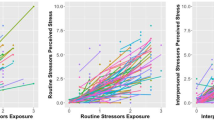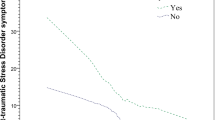Abstract
Law enforcement personnel (LEPs) experience occupational stressors that can result in poor health outcomes and have a negative impact on the communities they serve. Dispositional mindfulness, or receptive awareness and attention to present moment experience, has been shown to negatively predict perceived stress and to moderate the relationship between stressors and negative stress-related outcomes. The current study is an investigation of the moderating role of specific facets of dispositional mindfulness (i.e., nonreactivity, nonjudging, and acting with awareness) in the relationship between occupational stressors and perceived stress in a sample of LEPs. As hypothesized, nonreactivity significantly moderated the relationship between operational stressors and perceived stress, such that LEPs low in nonreactivity exhibited a significant relationship between stressors and perceived stress, whereas those high in nonreactivity did not. Nonjudging also moderated the relationship between organizational stressors and perceived stress; however, unexpectedly, LEPs high in nonjudging evidenced a significant relationship between stressors and perceived stress, whereas those low in nonjudging did not. Potential implications of these findings for LEP stress reduction interventions are discussed.


Similar content being viewed by others
References
Baer RA, Smith GT, Hopkins J, Krietemeyer J, Toney L (2006) Using self-report assessment methods to explore facets of mindfulness. Assessment 13(1):27–45. https://doi.org/10.1177/1073191105283504
Baer RA, Smith GT, Hopkins J, Krietemeyer J, Toney L (2016) Using self-report assessment methods to explore facets of mindfulness. Assessment 13(1):27–45
Bergman AL, Christopher MS, Bowen S (2016) Changes in facets of mindfulness predict stress and anger outcomes for police officers. Mindfulness:1–8
Bohlmeijer E, Peter M, Fledderus M, Veehof M, Baer R (2011) Psychometric properties of the Five Facet Mindfulness Questionnaire in depressed adults and development of a short form. Assessment 18(3):308–320. https://doi.org/10.1177/1073191111408231
Brown KW, Ryan RM (2003) The benefits of being present: mindfulness and its role in psychological well-being. J Pers Soc Psychol 84(4):822–848. https://doi.org/10.1037/0022-3514.84.4.822
Chopko BA, Schwartz RC (2013) The relation between mindfulness and posttraumatic stress symptoms among police officers. J Loss Trauma 18(1):1–9. https://doi.org/10.1080/15325024.2012.674442
Christopher MS, Woodrich LE, Tiernan KA (2014) Using cognitive interviews to assess the cultural validity of state and trait measures of mindfulness among Zen Buddhists. Mindfulness 5(2):145–160. https://doi.org/10.1007/s12671-012-0160-z
Christopher MS, Goerling RJ, Rogers BS, Hunsinger MH, Baron G, Bergman A, Zava DT (2016) A pilot study of evaluating the effectiveness of a mindfulness-based intervention on cortisol awakening response and health outcomes among law enforcement officers. J Police Crim Psychol 31(1):15–28. https://doi.org/10.1007/s11896-015-9161-x
Ciesla JA, Reilly LC, Dickson KS, Emanuel AS, Updegraff JA (2012) Dispositional mindfulness moderates the effects of stress among adolescents: rumination as a mediator. J Clin Child Adolesc Psychol 41(6):760–770. https://doi.org/10.1080/15374416.2012.698724
Clark DW, White EK, Violanti JM (2012) Law enforcement suicide: current knowledge and future directions. Police Chief 79:48–51
Cohen S, Williamson G (1988) Perceived Stress in a Probability Sample of the United States. Spacapan S, and Oskamp S (eds) The Social Psychology of Health. Sage, Newbury Park, p 198
Colgan D, Christopher M, Michael P, Wahbeh H (2016) The body scan and mindful breathing among veterans with PTSD: type of intervention moderates the relationship between changes in mindfulness and post-traumatic depression. Mindfulness 7(2):372–383. https://doi.org/10.1007/s12671-015-0453-0
Dale SK, Cohen MH, Kelso GA, Cruise RC, Weber KM, Watson C, Brody LR (2014) Resilience among women with HIV: impact of silencing the self and socioeconomic factors. Sex Roles 7:221–231. https://doi.org/10.1007/s11199-014-0348-x
de Bruin EI, Topper M, Muskens JG, Bögels SM, Kamphuis JH (2012) Psychometric properties of the Five Facets Mindfulness Questionnaire (FFMQ) in a meditating and a non-meditating sample. Assessment 19(2):187–197. https://doi.org/10.1177/1073191112446654
Gartland N, O’Connor DB, Lawton R, Ferguson E (2014) Investigating the effects of conscientiousness on daily stress, affect and physical symptom processes: a daily diary study. Br J Health Psychol 19(2):311–328
Hayes AF (2012) PROCESS: a versatile computational tool for observed variable mediation, moderation, and conditional process modeling [White paper]. Retrieved from http://www.afhayes.com/public/process2012.pdf
Inslicht SS, Otte C, McCaslin SE, Apfel BA, Henn-Haase C, Metzler T, Yehuda R, Neylan TC, Marmar CR (2011) Cortisol awakening response prospectively predicts peritraumatic and acute stress reactions in police officers. Biol Psychiatry 70(11):1055–1062. https://doi.org/10.1016/j.biopsych.2011.06.030
Ma CC, Andrew ME, Fekedulegn D, Gu JK, Hartley TA, Charles LE, Violanti JM, Burchfiel CM (2015) Shift work and occupational stress in police officers. Saf Health Work 6(1):25–29. https://doi.org/10.1016/j.shaw.2014.10.001
Marks AD, Sobanski DJ, Hine DW (2010) Do dispositional rumination and/or mindfulness moderate the relationship between life hassles and psychological dysfunction in adolescents. Austr N Z J Psychiatry 44(9):831–838. https://doi.org/10.3109/00048674.2010.487478
Marmar CR, McCaslin SE, Metzler TJ, Best S, Weiss DS et al (2006) Predictors of posttraumatic stress in police and other first responders. Ann N Y Acad Sci 1071(1):1–18. https://doi.org/10.1196/annals.1364.001
McCraty R, Atkinson M (2012) Resilience training program reduces physiological and psychological stress in police officers. Glob Adv Health Med 1(5):42–64
McCreary DR, Thompson MM (2006) Development of two reliable and valid measures of stressors in policing: the operational and organizational police stress questionnaires. Int J Stress Manag 13(4):494–518. https://doi.org/10.1037/1072-5245.13.4.494
Nieuwenhuys A, Cañal-Bruland R, Oudejans RRD (2012) Effects of Threat on Police Officers’ Shooting Behavior: Anxiety, Action Specificity, and Affective Influences on Perception. Appl Cogn Psychol 26(4):608–615
Peters JR, Eisenlohr-Moul TA, Upton BT, Baer RA (2013) Nonjudgment as a moderator of the relationship between present-centered awareness and borderline features: synergistic interactions in mindfulness assessment. Personal Individ Differ 55(1):24–28. https://doi.org/10.1016/j.paid.2013.01.021
Rajaratnam SW, Brager LK, Lockley SW, Shea SA, Wang W, Landrigan CP, Czeisler CA (2011) Sleep disorders, health and safety in police officers. J Am Med Assoc 306(23):2567–2578. https://doi.org/10.1001/jama.2011.1851
Rees B, Smith J (2008) Breaking the silence: the traumatic circle of policing. Int J Police Sci Manag 10(2):267–279. https://doi.org/10.1350/ijps.2008.10.3.83
Shane JM (2010) Organizational stressors and police performance. J Crim Justice 38(4):807–818
Storey JE, Gibas AL, Reeves KA, Hart SD (2011) Evaluation of a violence risk (threat) assessment training program for police and other criminal justice professionals. Crim Justice Behav 38(6):554–564. https://doi.org/10.1177/0093854811403123
Tuckey MR, Winwood PC, Dollard MF (2012) Psychosocial culture and pathways to psychological injuries within policing. Police Pract Res 13(3):224–240. https://doi.org/10.1080/15614263.2011.574072
Vasunilashorn S, Lynch SM, Glei DA, Weinstein M, Goldman N (2014) Exposure to stressors and trajectories of perceived stress among older adults. J Gerontol B Psychol Sci Soc Sci 70(2):329–337. https://doi.org/10.1093/geronb/gbu065
Walvekar, SS (2015) Study on serum cortisol and Perceived Stress Scale in the police constables. J Clin Diagn Res 9(2):BC10–BC12
Wang Z, Inslicht SS, Metzler TJ, Henn-Haase C, McCaslin SE, Tong H, Neylan TC, Marmar CR (2010) A prospective study of predictors of depressive symptoms in police. Psychiatry Res 175(3):211–216. https://doi.org/10.1016/j.psychres.2008.11.010
Williams V, Ciarrochi J, Deane FP (2010) On being mindful, emotionally aware, and more resilient: longitudinal pilot study of police stress. Aust Psychol 45(4):274–282. https://doi.org/10.1080/00050060903573197
Wirth M, Burch J, Violanti J, Burchfiel C, Fekedulegn D, Andrew M, Zhang H, Miller DB, Hebert JR, Vena JE (2013) Shiftwork duration and the awakening cortisol response among police officers. Chronobiol Int 28(5):446–457. https://doi.org/10.3109/07420528.2011.573112
Zimmaro LA, Salmon P, Naidu H, Rowe J, Phillips K, Rebholz WN, Giese-Davis J, Cash E, Dreeben SJ, Bayley-Veloso R, Jablonski M, Hicks A, Siwik C, Sephton SE (2016) Association of dispositional mindfulness with stress, cortisol, and well-being among university undergraduate students. Mindfulness 7(4):874–885
Author information
Authors and Affiliations
Corresponding author
Rights and permissions
About this article
Cite this article
Kaplan, J.B., Christopher, M.S. & Bowen, S. Dispositional Mindfulness Moderates the Relationship Between Occupational Stressors and Perceived Stress Among Law Enforcement Personnel. J Police Crim Psych 33, 227–232 (2018). https://doi.org/10.1007/s11896-017-9246-9
Published:
Issue Date:
DOI: https://doi.org/10.1007/s11896-017-9246-9




